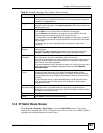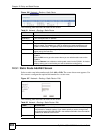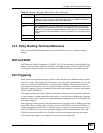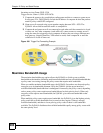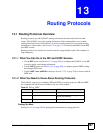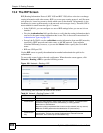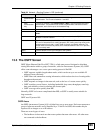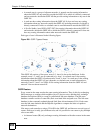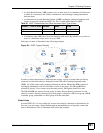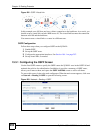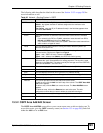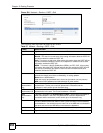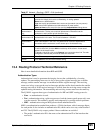
Chapter 13 Routing Protocols
ZyWALL USG 100/200 Series User’s Guide
291
• An Area Border Router (ABR) connects two or more areas. It is a member of all the areas
to which it is connected, and it filters, summarizes, and exchanges routing information
between them.
• An Autonomous System Boundary Router (ASBR) exchanges routing information with
routers in networks outside the OSPF AS. This is called redistribution in OSPF.
• A backbone router (BR) has at least one interface with area 0. By default, every router in
area 0 is a backbone router, and so is every ABR.
Each type of router is illustrated in the following example.
Figure 201 OSPF: Types of Routers
In order to reduce the amount of traffic between routers, a group of routers that are directly
connected to each other selects a designated router (DR) and a backup designated router
(BDR). All of the routers only exchange information with the DR and the BDR, instead of
exchanging information with all of the other routers in the group. The DR and BDR are
selected by priority; if two routers have the same priority, the highest router ID is used.
The DR and BDR are selected in each group of routers that are directly connected to each
other. If a router is directly connected to several groups, it might be a DR in one group, a BDR
in another group, and neither in a third group all at the same time.
Virtual Links
In some OSPF AS, it is not possible for an area to be directly connected to the backbone. In
this case, you can create a virtual link through an intermediate area to logically connect the
area to the backbone. This is illustrated in the following example.
Table 95 OSPF: Redistribution from Other Sources to Each Type of Area
SOURCE \ TYPE OF AREA NORMAL NSSA STUB
Static routes Yes Yes No
RIP Yes Yes Yes



